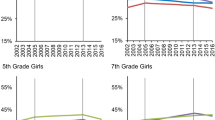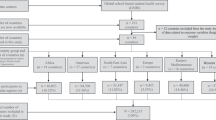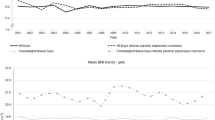Abstract
Objectives
To examine longitudinal effects of school policies on children’s weight status and eating behaviors, and study how these effects may vary by children’s age, sex, and baseline weight status in China.
Methods
Data were collected in 2015, 2016, and 2017 in an open cohort of 3298 children aged 6–17, their parents, and schools in five large cities across China (Beijing, Shanghai, Xi’an, Nanjing, and Chengdu). Children’s weight, height, and waist circumference were measured, and their eating behaviors were self-reported. The 1691 children with such repeated measures in ≥ two waves were included in longitudinal data analysis with mixed effects models, testing the associations.
Results
Having school vicinity food stall policy was associated with less frequent consumption of fast food (β = −0.14, p < 0.01) and snack (β = −0.84, p < 0.01). More significant associations were found between school policies and unhealthy eating behaviors for girls and children aged 6–11 than their counterparts. Among children without overweight or central obesity at baseline, having school cafeteria food policy was associated with lower risks for overweight and obesity (OR = 0.33, 95% CI: 0.17–0.63) and central obesity (OR = 0.47, 95% CI: 0.26–0.85). This existed for girls, but not for boys. School vicinity food stall policy was associated with lower BMI (β = −0.20, 95% CI: −0.37, −0.03) among all children and in girls (β = −0.28, 95% CI: −0.50, −0.05) without overweight at baseline.
Conclusions
School policies could reduce children’s unhealthy eating behaviors and obesity risk in megacities in China. Children’s age, sex, and baseline weight status modify the effects. School policies are important to fight the growing childhood obesity epidemic.
This is a preview of subscription content, access via your institution
Access options
Subscribe to this journal
Receive 12 print issues and online access
$259.00 per year
only $21.58 per issue
Buy this article
- Purchase on Springer Link
- Instant access to full article PDF
Prices may be subject to local taxes which are calculated during checkout
Similar content being viewed by others
Data availability
All data included in this study are available.
References
Lobstein T, Jackson-Leach R, Moodie ML, Hall KD, Gortmaker SL, Swinburn BA, et al. Child and adolescent obesity: part of a bigger picture. Lancet. 2015;385:2510–20.
Zhao Y, Wang L, Xue B, Wang Y. Associations between general and central obesity and hypertension among children: the childhood obesity study in China mega-cities. Sci Rep. 2017;7:16895.
Wang Y, Zhao L, Gao L, Pan A, Xue H. Health policy and public health implications of obesity in China. Lancet Diabetes Endocrinol. 2021;9:446–61.
Jia P, Li M, Xue H, Wang W, Wang Y. School environment and policies, child eating behavior and overweight/obesity in urban China: the childhood obesity study in China megacities. Int J Obes. 2017;41:813–9.
Wang Y MA. Beydoun. The obesity epidemic in the United States—gender, age, socioeconomic, racial/ethnic, and geographic characteristics: a systematic review and meta-regression analysis. Epidemiol Rev. 2007;29:6–28.
Li M, Xue H, Jia P, Zhao Y, Wang Z, Xu F, et al. Pocket money, eating behaviors, and weight status among Chinese children: the childhood obesity study in China mega-cities. Prev Med. 2017;100:208–15.
Wang Y, Wang L, Qu W. New national data show alarming increase in obesity and noncommunicable chronic diseases in China. Eur J Clin Nutr. 2017;71:149–50.
Jia P, Xue H, Zhang J, Wang Y. Time trend and demographic and geographic disparities in childhood obesity prevalence in China-evidence from twenty years of longitudinal data. Int J Environ Res Public Health. 2017;14:E369.
Jia P, Ma S, Qi X, Wang Y. Spatial and temporal changes in prevalence of obesity among Chinese children and adolescents, 1985-2005. Prev Chronic Dis. 2019;16:E160.
Li X, Song J, Lin T, Dixon J, Zhang G, Ye H. Urbanization and health in China, thinking at the national, local and individual levels. Environ Health. 2016;15:S32.
Nishtar S, Gluckman P, Armstrong T. Ending childhood obesity: a time for action. Lancet. 2016;387:825–7.
Vepsäläinen H, Mikkilä V, Erkkola M, Broyles ST, Chaput JP, Hu G. Association between home and school food environments and dietary patterns among 9–11-year-old children in 12 countries. Int J Obes Suppl. 2015;5:S66–73.
Pineda E, Swinburn B, Sassi F. Effective school food environment interventions for the prevention of childhood obesity: systematic review and meta-analysis. Lancet. 2019;394:S77.
Williams AJ, Henley WE, Williams CA, Hurst AJ, Logan S, Wyatt KM. Systematic review and meta-analysis of the association between childhood overweight and obesity and primary school diet and physical activity policies. Int J Behav Nutr Phys Activity. 2013;10:101.
Li M, Xue H, Wen M, Wang W, Wang Y. Nutrition and physical activity related school environment/policy factors and child obesity in China:a nationally representative study of 8573 students in 110 middle schools. Pediatr Obes. 2017;12:485–93.
Yau J, Smetana JG, Metzger A. Young Chinese children’s authority concepts. Soc Dev. 2009;18:210–29.
Wang Y, Min J, Khuri J, Li M. A systematic examination of the association between parental and child obesity across countries. Adv Nutr. 2017;8:436–48.
National Health Commission of the People’s Republic of China. WS/T 586-2018 Screening for overweight and obesity among school-age children and adolescents. 2018.
Ma GS, Ji CY, Ma J, Mi J, Sung Ry, Xiong F. Waist circumference reference values for screening cardiovascular risk factorsin Chinese children and adolescents aged 7–18 years. Zhonghua Liu Xing Bing Xue Za Zhi. 2010;31:609–15.
Sallis JF, McKenzie TL, Conway TL, Elder JP, Prochaska JJ, Brown M. Environmental interventions for eating and physical activity: a randomized controlled trial in middle schools. Am J Prev Med. 2003;24:209–17.
Tovée MJ, Hancock PJ, Mahmoodi S, Singleton BR, Cornelissen PL. Human female attractiveness: waveform analysis of body shape. Proc R Soc B. 2002;269:2205–13.
Sarwer DB, Grossbart TA, Didie ER. Beauty and society. Semin Cutan Med Surg. 2003;22:79–92.
Song Y, Wang HJ, Ma J, Wang Z. Secular trends of obesity prevalence in urban Chinese children from 1985 to 2010: gender disparity. PLoS ONE. 2013;8:e53069.
Li Y. Social factors of childhood obesity in Chinese urban children. Stud Preschool Educ. 2008;159:37–40.
Li J, Lei J, Wen S, Zhou L. Sex disparity and perception of obesity/overweight by parents and grandparents. Paediatr Child Health. 2014;19:e113–6.
Sun H, Ma Y, Han D, Pan CW, Xu Y. Prevalence and trends in obesity among China’s children and adolescents, 1985–2010. PLoS ONE. 2014;9:e105469.
Neumark-Sztainer D, French SA, Hannan PJ, Story M, Fulkerson JA. School lunch and snacking patterns among high school students: associations with school food environment and policies. Int J Behav Nutr Phys Activity. 2005;2:14.
Pulgaron ER, Delamater AM. Obesity and type 2 diabetes in children: epidemiology and treatment. Curr Diab Rep. 2014;14:508.
Jodkowska M, Oblacinska A, Tabak I, Radiukiewicz K. Differences in dietary patterns between overweight and normal-weight adolescents. Med Wieku Rozwoj. 2011;15:266–73.
Li XH, Lin S, Guo H, Huang Y, Wu L, Zhang Z. Effectiveness of a school-based physical activity intervention on obesity in school children: a nonrandomized controlled trial. BMC Public Health. 2014;14:1282.
Ritchie LD, Wakimoto P, Woodward-Lopez G, Thompson FE, Loria CM, Wilson DK. et al. The healthy communities study nutrition assessments: child diet and the school nutrition environment. Am J Prev Med. 2015;49:647–52.
Jia P, Xue H, Cheng X, Wang Y. Effects of school neighborhood food environments on childhood obesity at multiple scales: a longitudinal kindergarten cohort study in the USA. BMC Med. 2019;17:99.
Yang S, Zhang X, Feng P, Wu T, Tian R, Zhang D, et al. Access to fruit and vegetable markets and childhood obesity: a systematic review. Obes Rev. 2021;22:e12980.
Jia P, Yang H, Cao X, Yuan C, Xiao Q, Yang S, et al. Association between access to full-service restaurants and childhood obesity. Obes Rev. 2021;22:e13076.
Xin JG, Zhao L, Wu T, Zhang LH, Li Y, Xue H, et al. Association between access to convenience stores and childhood obesity: a systematic review. Obes Rev. 2021;22:e12908.
Acknowledgements
This work was supported by the National Natural Science Foundation of China (42271433), Wuhan University Specific Fund for Major School-level Internationalization Initiatives (WHU-GJZDZX-PT07), and the International Institute of Spatial Lifecourse Health (ISLE). We want to thank all the collaborators and study participants in the Childhood Obesity Study in China Megacities (COCM).
Author information
Authors and Affiliations
Contributions
YXD, LM, PJ, HX, FX, LZ, BX, WY, and YFW contributed to the study design, data collection, and drafting the paper. YXD and LM contributed to the data analysis. YXD, LM, and PJ drafted the paper. YFW directed the data collection and provided administrative support for the project. All authors contributed to interpretation of the data, commented on and revised the paper, and approved the final version for publication.
Corresponding author
Ethics declarations
Competing interests
The authors declare no competing interests.
Additional information
Publisher’s note Springer Nature remains neutral with regard to jurisdictional claims in published maps and institutional affiliations.
Rights and permissions
Springer Nature or its licensor holds exclusive rights to this article under a publishing agreement with the author(s) or other rightsholder(s); author self-archiving of the accepted manuscript version of this article is solely governed by the terms of such publishing agreement and applicable law.
About this article
Cite this article
Ding, Y., Ma, L., Jia, P. et al. Longitudinal effects of school policies on children’s eating behaviors and weight status: findings from the childhood obesity study in China megacities. Int J Obes 47, 17–23 (2023). https://doi.org/10.1038/s41366-022-01206-z
Received:
Revised:
Accepted:
Published:
Issue Date:
DOI: https://doi.org/10.1038/s41366-022-01206-z



